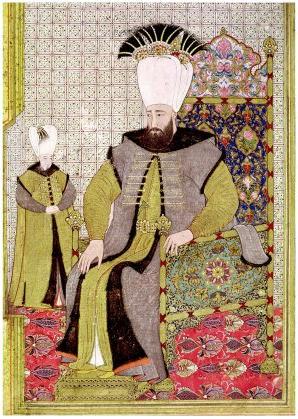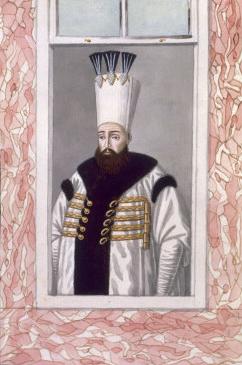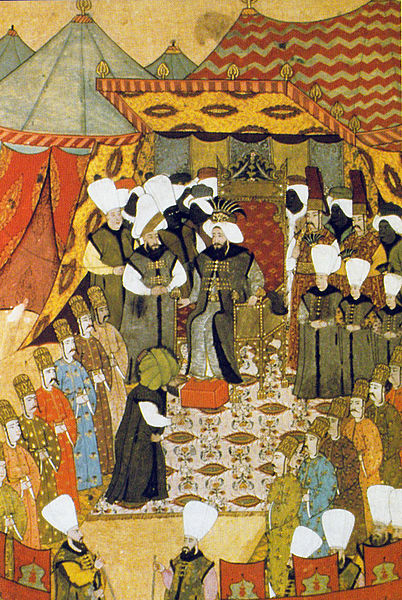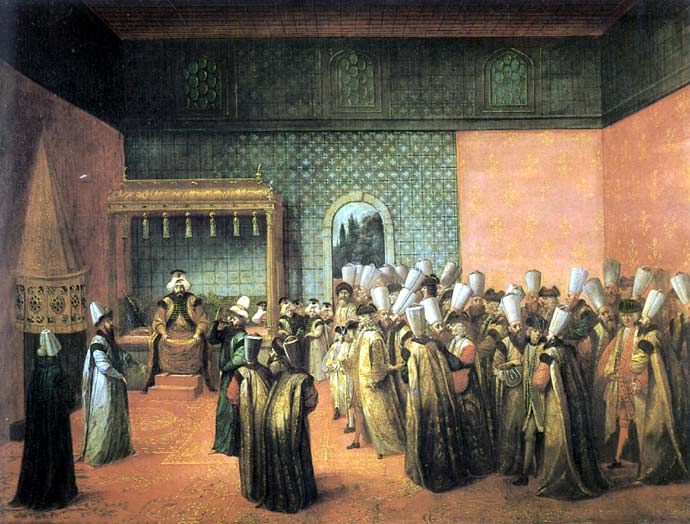<Back to Index>
- Mathematician Stanisław Saks, 1897
- Composer André Charles Prosper Messager, 1853
- Sultan of the Ottoman Empire Ahmed III, 1673
PAGE SPONSOR



Ahmed III (Ottoman Turkish: احمد ثالث Aḥmed-i sālis) (December 30/31, 1673 – July 1, 1736) was Sultan of the Ottoman Empire and a son of Sultan Mehmed IV (1648 – 87). His mother was Mâh-Pâre Ummatullah (Emetullah) Râbi'a Gül-Nûş Valide Sultan, originally named Evmania Voria, who was an ethnic Greek. He was born at Hajioglupazari, in Dobruja. He succeeded to the throne in 1703 on the abdication of his brother Mustafa II (1695 – 1703). Nevşehirli Damat İbrahim Pasha and his daughter, Princess Hatice (wife of the former) directed the government from 1718 to 1730, a period referred to as the Tulip Era.
Ahmed III cultivated good relations with France, doubtless in view of Russia's menacing attitude. In fact both his wives were Frenchwomen. He awarded refuge in Ottoman territory to Charles XII of Sweden (1682 – 1718) after the Swedish defeat at the hands of Peter I of Russia (1672 – 1725) in the Battle of Poltava of 1709. King Charles XII of Sweden escaped to the Ottoman Empire after losing the Battle of Poltava against the Russians, which was a part of the Great Northern War. In 1710 he convinced the Ottoman Sultan Ahmed III to declare war against Russia, and the Ottoman forces under Baltacı Mehmet Pasha won a major victory at the Battle of Prut. In the aftermath, Russia returned Azov back to the Ottomans, agreed to demolish the fortress of Taganrog and others in the area, and to stop interfering into the affairs of the Polish - Lithuanian Commonwealth.
Forced against his will into war with Russia, Ahmed III came nearer than any Ottoman sovereign before or since to breaking the power of his northern rival, whose armies his grand vizier Nevşehirli Damat İbrahim Pasha succeeded in completely surrounding at the Pruth River Campaign in 1711. The subsequent Ottoman victories against Russia enabled the Ottoman Empire to advance to Moscow, had the Sultan wished. However, this was halted as a report reached Constantinople that the Safavids were invading the Ottoman Empire, causing a period of panic, turning the Sultan's attention away from Russia.
Sultan Ahmed III had become unpopular by reason of the excessive pomp and costly luxury in which he and his principal officers indulged; on September 20, 1730, a mutinous riot of seventeen janissaries, led by the Albanian Patrona Halil, was aided by the citizens as well as the military until it swelled into an insurrection in front of which the sultan was forced to give up the throne.
Ahmed voluntarily led his nephew Mahmud I (1730 – 54) to the seat of sovereignty and paid allegiance to him as Sultan of the Empire. He then retired to the Kafes previously occupied by Mahmud and died at Topkapı Palace after six years of confinement. The reign of Ahmed III, which had lasted for twenty - seven years, although marked by the disasters of the Great Turkish War, was not unsuccessful. The recovery of Azov and the Morea, and the conquest of part of Persia, managed to counterbalance the Balkan territory ceded to the Habsburg Monarchy through the Treaty of Passarowitz, after the Ottoman Empire was defeated in the Austro - Turkish War of 1716 - 18. In 1716, he sent and army of 33,000 men to capture Corfu from the Republic of Venice. Ahmed
III left the finances of the Ottoman Empire in a flourishing condition,
which had remarkably been obtained without excessive taxation or extortion procedures. He was a cultivated patron of literature and art, and it was in his time that the first printing press authorized to use the Arabic or Turkish languages was set up in Constantinople, operated by Ibrahim Muteferrika (while
the printing press had been introduced to Constantinople in 1480, all
works published before 1729 were in Greek, Armenian, or Hebrew). It was in this reign that an important change in the government of the Danubian Principalities was introduced: previously, the Porte had appointed Hospodars, usually native Moldavian and Wallachian boyars, to administer those provinces; after the Russian campaign of 1711, during which Peter the Great found an ally in Moldavia Prince Dimitrie Cantemir, the Porte began overtly deputizing Phanariote Greeks in that region, and extended the system to Wallachia after Prince Stefan Cantacuzino established links with Eugene of Savoy. The Phanariotes constituted a kind of Dhimmi nobility, which supplied the Porte with functionaries in many important departments of the state.
He married Aminā (Emine) Mihr-î-Mâh Sultan, and Râbi'a Sermi Sultan. By first wife he had Mustafa III and by second wife he had Abdul Hamid I. A passage in Voltaire's Candide has the book's eponymous main character meet the deposed Ahmed III while on a ship from Venice to Constantinople.
The Sultan is in the company of five other deposed European monarchs,
and he tells Candide, who initially doubts his credentials: I
am not jesting, my name is Achmet III. For several years I was Sultan;
I dethroned my brother; my nephew dethroned me; they cut off the heads
of my viziers; I am ending my days in the old seraglio; my nephew,
Sultan Mahmoud, sometimes allows me to travel for my health, and I have
come to spend the Carnival at Venice". This episode was taken up by the modern Turkish writer Nedim Gürsel and made into the setting of his 2001 novel Le voyage de Candide à Istanbul. In
fact, there is no evidence of the deposed Sultan being allowed to make
such foreign travels, nor did Voltaire (or Gürsel) assert that it
had any actual historical foundation.
